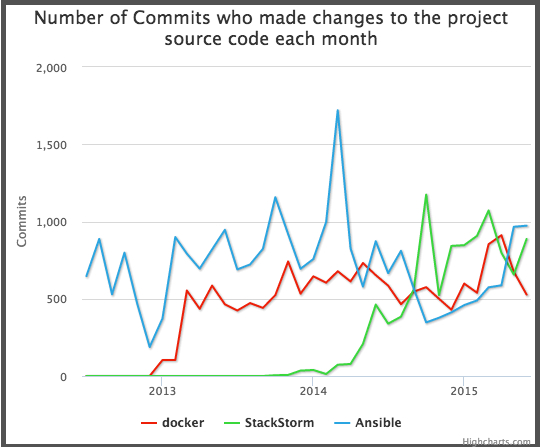Guest post by Jurnell Cockhren, CTO and Founder of SophicWare
The task at hand is to connect Stackstorm to your pre-existing Saltstack infrastructure. Why? Well, by doing this you can turn all of your existing Salt actions into StackStorm actions, allowing you to use StackStorm for your overall event driven automation while Salt remains focused on remote execution and other use cases. This is a pattern we are increasingly seeing – so let’s try it out!
This blog covers both proper configuration of Saltstack NetAPI allowing for Stackstorm usage as well as how to install and configure the salt pack within StackStorm. This tutorial covers Scenario 2 listed on the Salt pack README.
July 28th, 2015
by Evan Powell
I’m extremely proud of the pace and quality of development ongoing here at StackStorm and in the broader community.
Lets take a look at a couple of metrics that imperfectly capture the vitality of the project and the amount of development being done. If you look at the graph below you can see that the number of commits per month is quite similar to Docker and Ansible. The source for this graph is OpenHub.Net

July 23, 2015
by Lakshmi Kannan
It’s almost end of summer in California and the sun is baking us all pretty nicely. We also had a richter 4.0 earthquake last night but nothing stops us from giving you another shiny release. 0.12.0 was released today with some new features and a bunch of bug fixes.
Take a moment to engage with us and the broader devops community by signing up with our slack community. We are also available on IRC on Freenode.
We have some interesting contributions from our users. James Sigurðarson added args support for our windows script runner, making our windows remote execution support more useful by specifying arguments to pass to these scripts.
Sayli Karmarkar (Netflix) added the ability to filter action executions by trigger instance to get better visibility.
July 21, 2015
by Evan Powell
Over the last 5 months, since March, we have published a number of content rich blogs. All told I counted some 25 that show users how to do something or provide an overview of a technical subject.
Here are the top 10 blogs in order of visitors:
July 15, 2015
by Evan Powell
Insights from WebEx Spark’s talk at the OpenStack Summit on how they boosted operational agility
Recently I watched again the presentation Reinhardt Quelle from Cisco Spark/ WebEx gave at the OpenStack Vancouver summit. It is an engaging presentation that covers a number of patterns, and a few anti patterns – everything from how they shifted their culture and org structure to Riak vs. Cassandra and PaaS vs. IaaS and much more besides. StackStorm does get a positive mention, so I’m biased – but that’s just a small piece of what is a great talk.
In this blog I’ll give you the cliff notes and some pointers to dive into relevant sections.
If you find this interesting I strongly recommend that you invest 45 minutes to watch the original.
Also – Reinhardt’s team will be co-hosting the upcoming Event Driven Automation Meet-up in San Francisco at their offices July 29th. Stop by to meet the team and dig in with them on these and other subjects.
Culture:
Reinhardt starts off by providing some context, beginning with the approach Cisco took to setting up Spark. Leadership had already determined that trying to gradually evolve WebEx operations and development towards DevOps best practices was fraught with difficulty and likely to fail.
July 08, 2015
by Dmitri Zimine
Recently someone on #stackstorm IRC asked how to build a simple troubleshooting automation: “on cron, ping a server, and dump the stats to the log for analytics; post the failure to Slack immediately if the ping fails.” Our short answer was “use Mistral workflow”. In this post, I’ll use this simple case to walk you through the details of setting up a basic automation, powered by Mistral workflow.
Mistral is a workflow service that we help develop upstream in OpenStack. It gives features and reliability that are missing in simple workflows like our own ActionChain or Ansible’s (details in “Return of workflows”). Mistral comes embedded and supported with StackStorm.
The scenario I use here is obviously simplification: in a typical deployment, monitoring is set up to do heavy-lifting on issue identifications, and a variety of devops tools are used to troubleshoot and remediate issues. StackStorm gives a fair bunch of lego-blocks to integrate existing devops tools, and build more realistic automation workflows. Yet, the production development flow and the patterns are going to be just as in this simple example.
I’ll take an opportunity to go over some basics of using StackStorm. It’s all documented, but doesn’t hurt to repeat some in context, and share my tips and tricks.
For you impatient kinds: the final version is available as a pack on GitHub, made-ready to install.
June 30, 2015
by Patrick Hoolboom
Slack is an amazing tool but sending invitations was a little bit of a pain point for us. So we figured (like we do), let’s automate it! Before we dig in to how we did this, if you haven’t signed up for the StackStorm-Community, do it now: StackStorm-Community
First, I’d like to thank the academy…wait…wrong speech. In all seriousness, I found the following blog and it made writing these automation so simple. I have to give credit where credit is due:
levels.io/slack-typeform-auto-invite-sign-ups
So go tweet at him, or send him chocolates or ponies. He deserves it!
June 25, 2015
by Evan Powell and Patrick Hoolboom
These days StackStorm is used in so many ways by users big and small from CI/CD through to auto scaling and auto remediation that sometimes the most basic of use cases can get over-looked.
As folks like WebEx recently have explained, the first value they got out of StackStorm was pretty straight forward.
StackStorm enabled them to pull together all their existing automations – i.e. scripts – and to have them managed in one place.
As a user put it:
“now my scripts have an API! Now my scripts have a CLI and a GUI.”
And with over 1500 integrations, whether those are north bound passive and active sensors, or south bound actions including full support for Salt, Ansible, Chef and Puppet, your own scripts can be augmented with a huge variety of additional colors.
Before you know it you’ll be painting a beautiful picture. “That’s it, just some nice clouds here now.”
